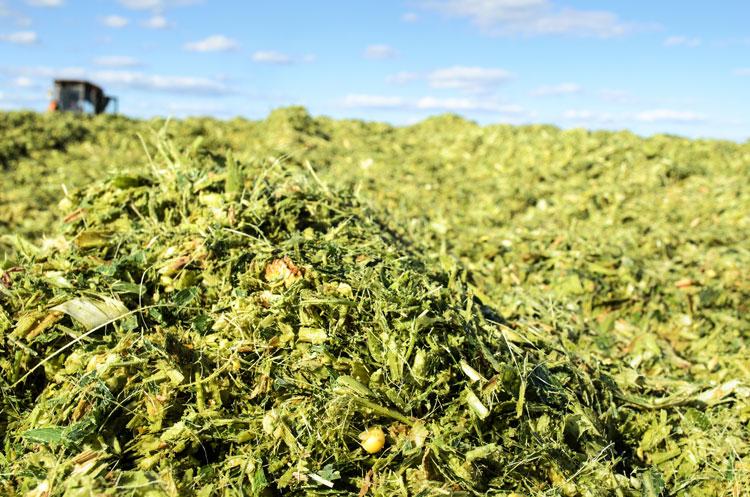The author is a dairy farmer in western Tennessee.

It was one of those crop years where we got fooled into thinking that our good management is what makes a good crop. In 2021, rains came on time and in the right quantities, and the corn made some of the best yields we’ve seen. But as we all know, there’s many a slip ‘twixt the cup and lip — or the chopper and the feedbunk.
We had about 40 acres of corn still standing once the bags were full. We looked at the options, and earlage seemed like a good choice. Our good friends close by do custom chopping and were willing to put the combine head on the chopper. Harvesting went smoothly, and we bagged 150 tons of nice earlage. As we worked, I thought the kernel processing (KP) was maybe lacking, but I assumed they were on top of things and didn’t press the issue, to my regret.
We used a good inoculant, judging by the price. So, maybe I can be forgiven for feeling pretty good about that bag of feed. I looked forward to feeding it and not buying so much hominy in the coming winter.
Brainstorming a bandage
December came, and we opened the earlage bag. It looked and smelled beautiful. But after a week or two of feeding it, washing down the parlor after milking was like washing down a corn bin. Apparently those KP rolls had been maximizing fuel efficiency, for less than 40% of kernels were cracked.
Dad and I milk together every morning and hold our business meetings to the tempo of pulsators, so we worked this problem over. There are just no good ways to reprocess earlage. Also, the weather was unusually warm, even for our area. Occasionally, we add water to the ration if it’s on the dry side, so it sounded like a smart idea to presoak the day’s worth of earlage in hopes of softening the kernels a bit.
After about three days of presoaking, Dad really cranked up the water, soaking the earlage in the mixer for 12 or even 24 hours before loading the rest of the feed (we feed once a day). Does any of this sound like the beginning steps of brewing moonshine?
Bad got worse
One Friday, I noticed a few cows off in milk, with poor rumen fill and loose manure. Our protocol for this is a mineral and probiotic bolus, but on Saturday, the same cows were breathing hard, and more were starting to have diarrhea. Hmmm. The business meeting got pretty serious that morning. I called our nutritionist, and he was horrified at the idea of presoaking earlage. We stopped the soaking cold turkey.
Still, the damage was done. In my 39 years, I have never seen a herd of Holsteins plummet off a cliff like these. On Sunday, I started treating cows with antibiotics. Our nutritionist helped us find toxin binders and yeast products to get in the ration. A number of cows morphed into walking bone bags, squirting diarrhea and breathing hard. By Tuesday, we had close to 40 out of 100 cows on some kind of treatment, and more that probably should have been. The tank weight tanked spectacularly.
Thank the Lord, cows do a pretty good job of being cows if we just let them. These girls got back on track in a week or so. The nutritionist’s over-the-phone shot-from-the-hip turned out to be about right. No major amount of toxins turned up in the samples I hustled off to the lab. By the time the lab results came back, our keel was more or less even again.
Lessons in pride
What did we learn? Among other things, KP scores really do matter. I don’t know what the roll gap was on that chopper; I never asked, and I don’t believe the owner knew.
In the end, we took the head off our chopper and built an elaborate funnel out of oak lumber and roofing metal, and every day for the next four months, we ran the day’s worth of earlage back through the chopper, blowing it into the mixer. It was very time-consuming, but this got us a decently processed earlage, vastly improving the starch digestibility. We fed the toxin binders on hand and went back to our previous mineral program, and the cows did their part beautifully.
Another lesson is to never underestimate the power of microbes. Apparently, the all-day soaking had exploded whatever bacteria and wild yeast population was present. As our understanding of cows and the microbial world grows, we are ever more awed by the incredible attention to detail that went into these living creatures and by the immensity of what we don’t know or have gotten wrong. All those antibiotics did for our cows was give them a fighting chance to recover — and once the gut balances were restored, it was amazing how fast they got back in the harness.
Sometimes I think the most important lesson is humility. It was human neglect in the cornfield (my own) and well-meant ignorance on the feed mixer’s part that triggered this avalanche of events. Yet, that winter turned out reasonably well. How many times do I take credit for good results when it’s more like in spite of me rather than because of my efforts? Not to discredit good management, but at the end of the season, that good crop and the benefits we reaped from it were blessings from our Father in heaven.






